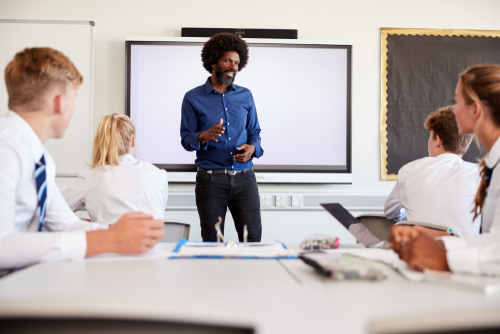The reality of teaching through a global pandemic is that many of our students haven’t set foot in an educational setting for 16 weeks and counting. With little warning, their lives as they knew them changed completely. As adults, the past few months have certainly been challenging, but imagine how hard it has been for our students.
Attending a farewell picnic at the end of the summer term for my Year 9 form, we were all overjoyed to see each other, but also wide eyed and confused by the situation. When schools return in September, some students will have been away for 24 weeks. As teachers, the pressure will be on to ‘catch-up’ on lost learning but how do we do this without also piling the pressure onto students?
Following government guidelines, schools are doing all they can to ensure that their young people are physically safe when they return, but how can we as teachers ensure they are emotionally safe? Read on for some suggestions on how to smooth the transition from the summer holidays to the start of the Autumn term.
Make time for discussion and socialising in the classroom
My students feel that their biggest upheaval is the lack of socialising. They have missed their routines, their teachers and their independence, but most of all their friendship groups. They want to talk through their experiences and catch up with friends – how do we make time for this in the classroom? You may have a huge discrepancy in the amount of work completed at home, with some students needing to re-adjust to listening, focusing and learning again.
I would suggest starting the term with discussion tasks, investigations and feedback heavy lessons. In English, this is a perfect opportunity for speaking and listening tasks – could they discuss the benefits of months at home? What life lessons did they learn? Or could you take the lesson’s context and deliver it though discussion or higher order questioning? Could maths lessons be achieved through investigatory discussions? Easing students into learning and the physicality of writing in exercise books whilst allowing them talk-space in your classroom may help their transition and wellbeing.
Calm and engage students in registration time
Registration time is also a key opportunity to check in with students, as well as to bring them together as a community to calm and engage them before a busy, and possibly overwhelming day. As a form teacher, these are the young people you know best.
A new class reader would be a lovely way to start; a book full of adventure, friendship people overcoming great odds could both settle, ground and motivate students. Phillip Pullman’s Northern Lights or Malorie Blackman’s Noughts and Crosses are both great places to start. I like to leave the books out so that if a student is feeling overwhelmed, they can read quietly without drawing attention to themselves or feeling self-conscious.
Another activity we enjoy as a form is learning a poem verbatim and standing collectively to recite it. ‘If’ by Rudyard Kipling and ‘Invictus’ by William Ernest Henley are so fitting for this period as well as being motivating and uplifting. There is something incredibly powerful in the action of standing as a group and acting as one voice together. It is this togetherness that young people have missed and it feels as if the school spirit and intention is gathered in these moments.
Check-in on wellbeing through lesson starters
I am expecting behaviour to be very different when students return to school in September, so I plan to use a wellbeing ‘check in’ starter for lessons once a week using the Thrive approach. The Thrive approach centres around positive mental health and emotional wellbeing in children and young adults, as well as teaching adults how to respond to differing behaviour. A Thrive starter I will be using has the following questions:
- Draw an image that represents how you are feeling right now. This gives students an opportunity to quickly sketch their feelings. It is also an activity young people of all abilities can be involved in. You may ask them to show their image and discuss it – sharing our emotions in the classroom can really support a group dynamic. Alternatively, you could return to these drawings later on a 1:1 basis with students you feel may need more in-depth conversations about their wellbeing. In either scenario, ask open questions such as ‘I see that you might be feeling unsettled, I imagine that might feel difficult. Would you like to tell me more about this?’
- Another way to check in with your young people might be to ask, ‘If you were a colour, what colour would you be?’
- Which word sums up your emotions right now?
- Plenary feedback: How can I help you more in lessons or in life? Responses to this question have included: recommend online resources around LBGTQ, speak to parents about concerns at home, deal with friendship issues, or asking to move seats away from students who are distracting them. Often young people are happier to discretely write their teacher a note in the margin, rather than draw attention to themselves by staying after class. I value these activities as a chance to say ‘I am here and I am listening’ to my students.
Support students through PSHE
There is an opportunity to catch up on their wellbeing though PSHE also. For example, Your Choice Book 2 chapters 1 and 12 address personal wellbeing and mental health. Chapter 2 discusses friendships and there are areas to discuss around relationships with parents too. These relationships may have changed with so much time spent all together and students may benefit from discussing this in small groups. Your school mentors and counsellors may also have ideas about ways in which to support students that could be shared on Inset days.
As teachers, we care deeply for our young people and look forwards to a return to a new normality as well as actually getting to see smiling faces. Some settings will continue to check in with students over the summer and I love hearing from schools who are sending postcards or emails over the summer to show students they are thinking of them. Small gestures like this will also go a long way in easing the transition when classes return.
For further free support, advice and wellbeing activities, download our wellbeing Reconnection packs to help smooth your students’ transition back to school.
Joanna Fliski is a freelance writer, secondary English teacher and primary school teacher in Bristol.



